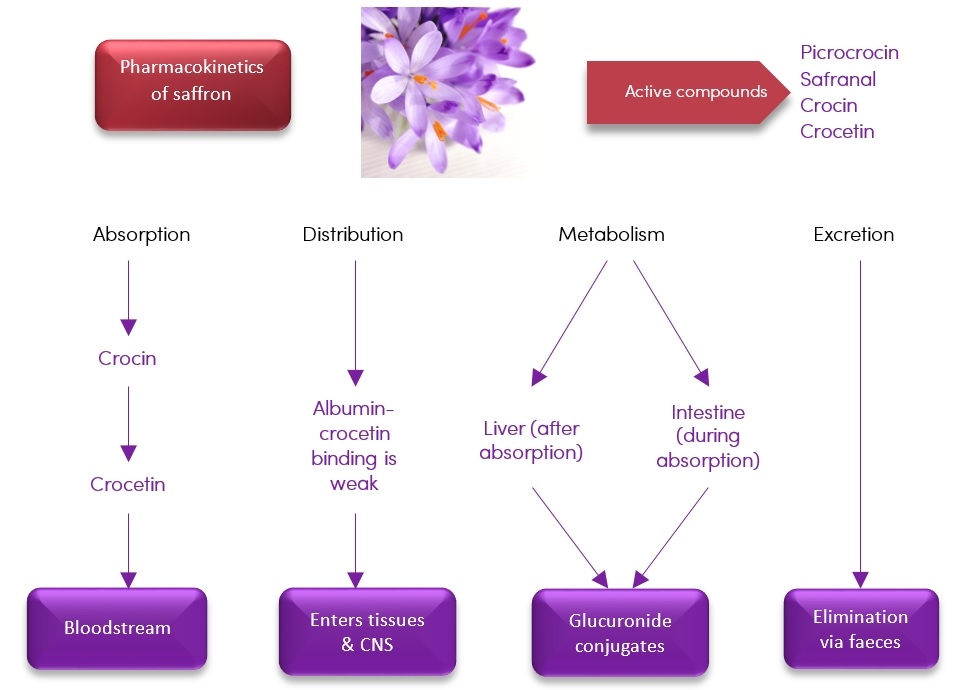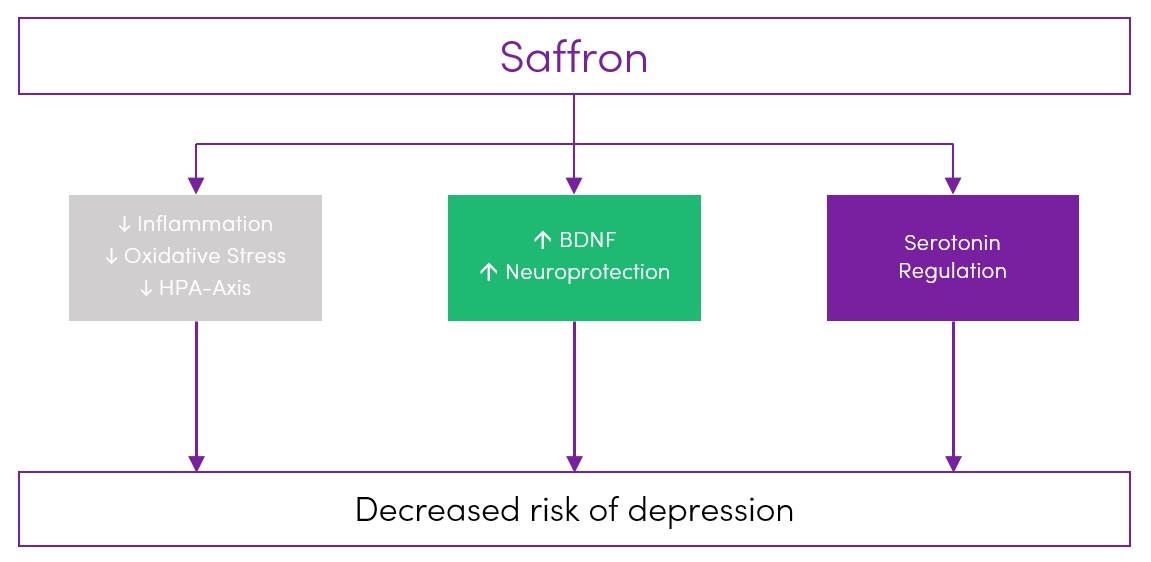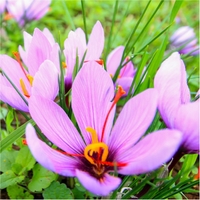
Absorption/Bioavailability
The research attributes the potential therapeutic value of saffron to the three main components present in the stigma: crocins, picrocrocin, and safranal.
There is limited information on the pharmacokinetics of safranal, although studies to date demonstrate low oral absorption (1). Picrocrocin has low absorptivity and bioavailability (2).
Crocins have low bioavailability after oral consumption because enzymes and intestinal microbiota rapidly hydrolyse them in the intestinal epithelium to deglycosylated trans-crocetin. Trans-crocetin is absorbed quickly by passive diffusion through the intestinal mucosa layer and distributed to body tissues including the central nervous system (CNS) (3,4,5). Crocetin is also converted to glucuronide conjugates in the liver, some of which serve as bioactive molecules in the body, while some are excreted as metabolic waste in bile or urine (6) (Figure 1).
Recently, the pharmacokinetics of a standardised saffron extract was investigated in healthy humans. The maximum concentration (Cmax) of crocetin in plasma was detected in blood 60 – 90 minutes after oral consumption of a single dose (56 mg or 84 mg), showing that crocin isomers from a standardised extract are rapidly transformed into crocetin (7). The fast presence of crocetin in blood plasma after the administration of the saffron extract contributes to understanding the beneficial effects of the standardised saffron extract observed in human clinical trials of depression and anxiety (8,9,10).
Crocetin is the only active metabolite that has been shown to be capable of crossing the blood-brain barrier and reach the CNS, regardless of whether pure crocetin or saffron extract is administered (11,12).
Figure 1. Pharmacokinetics of saffron

Mechanism of Action
Saffron and its constituents demonstrate positive effects on several neurobiological mechanisms involved in the pathogenesis of mental illness (Figure 2).
The exact mechanisms of saffron and its bioactive constituents in alleviating mood disorders are not yet fully elucidated, although evidence to date suggests multiple mechanisms:
- Serotonin reuptake inhibition in the synaptic terminals prolongs the half-life of serotonin throughout the brain and CNS, thereby alleviating symptoms of depression. Crocin and safranal show antidepressant activity by activating the serotonergic, noradrenergic, and dopaminergic systems, inhibiting the reuptake of serotonin, norepinephrine, and dopamine (13,14).
- Individuals with depression often exhibit alterations in HPA activity (14,15). In stress models, saffron modulates HPA axis activity by reducing cortisol concentrations (15,16,17).
- HPA axis dysfunction can reduce BDNF levels which affects neurogenesis and neuroplasticity and are associated with depression (18). Saffron and crocin exert neuroprotective effects by increasing BDNF in stress models (19,20).
- Crocetin can cross the blood-brain barrier and enter the CNS (20,21) and exert physiological effects on neuroprotection, neuroplasticity, and CNS activity (22).
- Depression is associated with immune activation and low-grade chronic inflammation. Saffron, crocin and crocetin have potent anti-inflammatory effects, inhibiting inflammatory cytokines including NF-kb, cyclooxygenase-2 (COX-2), IL-1, IL-6, and TNF-a (23,24).
- Major depression has been associated with nitrosative and oxidative stress and specifically lowered endogenous antioxidant enzymes (25). Saffron, safranal, crocin and crocetin are potent antioxidants. They can increase superoxide dismutase (SOD) levels and glutathione availability, and decrease markers of lipid peroxidation (26,27).
- Saffron and trans-crocetin have antagonistic effects on NMDA and sigma-1 receptors (28,29). Overactivation of these receptors can cause neuronal dysfunction and cell death (excitotoxicity) (30,31).
- Saffron, safranal and crocin may exert anxiolytic and hypnotic activity by interacting with the binding site of benzodiazepine in a GABA-A receptor (32).
Figure 2. Possible antidepressant mechanisms of action of saffron and its constituents

Cautions/Contraindications
Therapeutic doses of saffron and its constituents, such as those used in clinical investigations (typically 30 mg/day of extract or 120 mg of equivalent dried stigma per day), are considered safe.
Saffron is generally well tolerated, with few adverse events reported in clinical trials. Headache, nausea, anxiety, constipation, dry mouth, and appetite changes are the most common adverse events (27,33).
Saffron has been safely used as an adjunct to antidepressant medication in clinical trials, including fluoxetine (8,34), sertraline (35) and citalopram (35). Concurrent intake of saffron and SSRI for one month is safe and has no significant effect on blood clotting, platelet count, liver or kidney function or other haematological parameters (36).
Generally, daily doses of up to 1.5 g of saffron are considered safe in humans (37). Higher doses may cause gastrointestinal bleeding (acute dose of 2 g), toxicity (5 g), abortion (10 g) and fatality (20 g) (37). There is a caution for use in lactation, as supplementation during lactation decreased milk supply in two participants in a clinical trial (38).
Takeaway on saffron and mental health
- Accumulating evidence supports the use of saffron in treating adults with mild- to-moderate depression, and for improving depressive symptoms associated with other conditions, including menopause, PMS, post-partum depression, diabetes and metabolic syndrome.
- The evidence suggests that saffron is effective for improving anxiety symptoms, although further studies involving clinically anxious patients is required.
- Saffron and its constituents demonstrate positive effects on several neurobiological mechanisms involved in the pathogenesis of mental illness, including HPA axis modulating, anti-inflammatory, antioxidant, serotonergic and neuroprotective effects.
- The potential therapeutic value of saffron is largely attributed to crocins and safranal in the stigma; however, saffron petal had equal efficacy to the stigma in reducing depressive symptoms in a clinical trial, indicating other bioactive constituents, such as phenolic compounds present in the petal, also have antidepressant effects.
- Therapeutic doses of saffron (typically 30 mg/day) are considered safe and well-tolerated; and can be safely used as an adjunct to conventional antidepressant medication.
- The optimal dosage, treatment duration, extract source, as well as the mechanisms of action, still need to be clarified in further high-quality, multi centred controlled.



